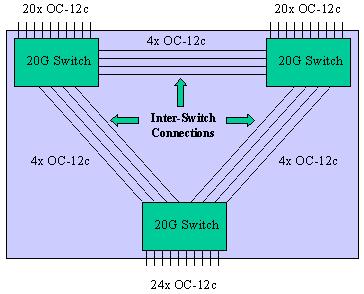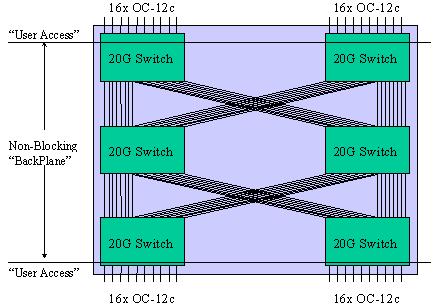Trying to Build a 40 Gbps Switch From Several, Smaller Switches.
Can't You Build a 40 Gbps Switch Out of Multiple Lower Speed Switches?
You can try to build the features of the ForeRunner®
ASX-4000 using smaller switches, but it is more expensive in terms of capital
and network engineering costs. Further, building larger backbones with
smaller switches usually results in dramatically lower performance. Vendors
of smaller switches try to provide either the physical port count or the
port count and the non-blocking capacity of the ASX-4000. The number of
smaller switches required depends on the goal.
For example, providing 64 OC-12c/STM-4c ports with 20
Gbps switches connected together, as shown below, will result in three
switches interconnected with blocking performance beyond 5 Gbps.

Using Three 20 Gbps Switches To Provide 64 User Ports
of OC-12c.
While you may realize the port count, this configuration
incurs additional rack space, VC space, provisioning and capital costs,
as well as a blocking solution.
To provide the port count and non-blocking capacity of
the ASX-4000 by using several 20 Gbps switches, requires six 20
Gbps switches, as the following illustration shows:

Using Six 20 Gbps Switches To Provide 40 Gbps Non-Blocking
Capacity.
Beyond the capital costs of six switches, building a 40
Gbps switch out of multiple lower speed switches results in network engineering
costs, such as:
-
Rack Space: Where space in the data center is at a
premium, the ASX-4000's relatively small footprint avoids the cost of extra
space for multiple switches.
-
VC Space: Multiple switches interconnected waste valuable
VC space resources by requiring the setting up of virtual channels for
inter-switch connections that should, ideally, be used for network connectivity.
-
PNNI Scaling and Performance: Multiple switches require
extra nodes and links in a PNNI topology database which affects scalability
and performance.
-
Load Balancing: With multiple switches, inter-switch
connections require effective load-balancing on the connections to achieve
true switch capacity. Multiple interconnected small switches can create
congestion unnecessarily by overloading one link when another is available.
This could lengthen link failure recovery times because a single switch
link in the cluster might have an unusually heavy load.
A single ASX-4000 switch provides guaranteed 40 Gbps of
non-blocking switch capacity through it's hardware architecture—not through
load-balancing.
-
Latency and Call Performance: Traffic going through
multiple switches adds latency to the network and decreases end-to-end
call performance.
The following table compares the number of switches and cost
figures (given the same base-price per OC-12c/STM-4c port) for a non-blocking
40 Gbps backbone, by switch size:
| Switch Capacity: |
Number of Switches: |
Relative Price: |
Approximate Cost:* |
| 40 Gbps |
One (1) |
the same |
US$512,000 |
| 20 Gbps |
Six (6) |
300% increase |
US$1,536,000 |
*With switches offering OC-12c/STM-4c at US$8,000
per port.
By providing 40 Gbps of non-blocking capacity in a single
unit, the ForeRunner ASX-4000 allows customers to avoid the capital
and network engineering costs required by deploying multiple lower capacity
switches.


